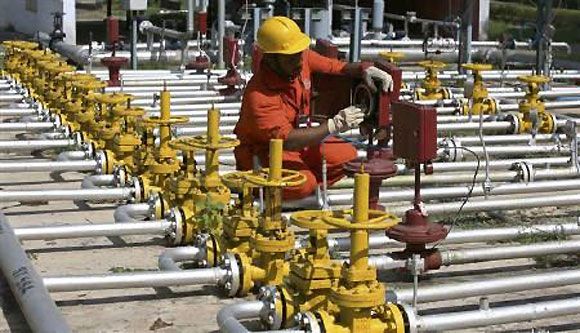 | « Back to article | Print this article |
 The government might have approved divesting five per cent of its 68.9 per cent stake in ONGC, but key concerns impacting the valuation of the country's biggest petroleum explorer remain.
The government might have approved divesting five per cent of its 68.9 per cent stake in ONGC, but key concerns impacting the valuation of the country's biggest petroleum explorer remain.
Among the major issues that are yet to be resolved are a lack of clarity on the overhaul of the subsidy-sharing mechanism by upstream companies, declining output from ageing and maturing fields, which have taken a toll on the overall output and uncertainty over new gas pricing guidelines.
The government wants to offload 427 million shares in ONGC, worth about Rs 18,000 crore, at current prices.
However, before that, it would also need to replace the company's three independent directors, appointed by the United Progressive Alliance government.
It had ordered the removal of the three from the board - former power secretary P Uma Shankar, former BPCL chairman R K Singh and chartered accountant S Ravi.
With their removal, the company is left with only three independent directors. According to Sebi norms, independent directors should constitute at least a third of a listed company's board.
ONGC currently has seven functional directors, including the chairman, and five non-executive directors.
ONGC's production, comprising crude oil and natural gas, has stagnated at around 60 million tonnes over the past five years since 2009-10, according to company data. In the last financial year, the ONGC group had registered an output of 59.2 million tonnes oil equivalent (mtoe) against 58.73 mtoe in the previous year.
In the first quarter ended June 2014, ONGC's crude output of 6.29 million tonnes (mt) was marginally lower than 6.45 mt during the same period last year.
ONGC's profit after tax (PAT) dropped 12 per cent from Rs 25,123 crore in 2011-12 to Rs 22,095 crore (Rs 220.95 billion) in 2013-14.
This was despite a 9.5 per cent rise in gross revenue to Rs 84,201 crore (Rs 842.01 billion) during this period, indicating squeezed margins.
To a large extent, stagnant production is due to a natural decline in output from ageing and maturing fields. Such fields account for 33 per cent of the firm's total crude output.
The high cost of production from such fields, due to the deployment of new technologies and 'enhanced oil recovery' schemes, continues to be an area of concern for earnings, the company recently said in a letter to the oil ministry.
The problem of stagnant production has been compounded by a huge burden of sharing under-recoveries of oil marketing companies (OMCs).
Even as gross under recoveries dipped 13 per cent to Rs 139,869 crore (Rs 1,398.69 billion) in FY14, ONGC's share was the highest ever at Rs 56,300 crore (Rs 563 billion).
The company had to provide a discount of $65.7 a barrel to OMCs, compared to $62.8 a barrel in the previous financial year. Net realisation, therefore, declined to $40.9 a barrel in FY14, which was 14 per cent less than the previous year's realisation of $47.8 a barrel.
The oil explorer now hopes for a financial relief with gross under recoveries likely to fall significantly in the current financial year, primarily owing to complete elimination of OMCs' losses on diesel sales.
This, however, might not be easy. "The burden on PSU upstream companies like ONGC continues to be fixed at around $56 per bbl (barrel) of crude oil production (at the end of the June quarter) and they may not benefit materially through a fall in under-recoveries in FY15, unless the sharing formula is revised by the fiscal year end," research firm ICRA said in a recent note.
ISSUES APLENTY
Lack of clarity on the overhaul of the subsidy-sharing mechanism by upstream companies
Declining output from ageing and maturing fields, which have taken a toll on the overall output and uncertainty over new gas-pricing guidelines
High production cost from ageing fields due to the deployment of new technologies and ‘enhanced oil recovery’ schemes